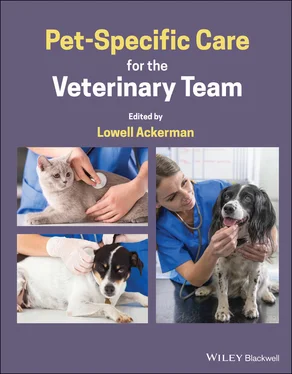DON'Tattempt to justify costs based on time or services provided. Clients don't care how much a particular piece of diagnostic equipment costs, how many staff members are involved in a pet's care, or how much time you'll need to spend to diagnose a pet. They care about the health of their pets and how your recommendations will help them.
DOdiscuss alternative payment options and ways to plan for future veterinary costs.
DON'Tdevalue your expertise by changing your recommendations when the pet owner indicates cost is a barrier.
Once you've made your recommendations and discussed cost, be prepared to offer alternative payment options for clients concerned about the price. Avoid altering your recommendations to decrease the cost of care. This devalues your expertise and can make the pet owner question the motives behind your initial recommendations. To help cover the immediate need, consider recommending third‐party financing (see 10.18Financing Veterinary Care) or a payment plan (see 10.17– Payment and Wellness Plans). Services like these allow you to offer payment plans to your clients without having to manage them in‐house. To prevent cost from becoming a barrier in the first place, educate all your clients on the benefits of pet health insurance (see 10.16Pet Health Insurance).
2.9.4 Preparing Clients for the Cost of Care Over a Pet's Lifetime
Educate your clients on the average costs of care long before you're facing an uncomfortable exam room situation. Tables 2.9.1and 2.9.2show the approximate costs of preventive care in the US for dogs living 12 years and cats living 15 years. (Unless otherwise noted, average costs of services are according to the tenth edition of The Veterinary Fee Reference [3].) These tables reflect only the cost of preventive care and do not include any costs associated with disease diagnosis or management. For additional information on likely costs of pet‐specific care programs, see 10.11The Financial Benefits of Pet‐Specific Medicine.
Table 2.9.1 Approximate cost of preventive and end‐of‐life care for dogs living 12 years
| Service |
Average cost |
Times during average lifespan |
Total |
| Preventive care exam (adult) (0–6 years) |
$45.20 |
7 |
$316.40 |
| Preventive care exam (senior) (biannually 7–12 years) |
$47.23 |
12 |
$566.76 |
| Annual heartworm panel (in‐house) |
$48.83 |
12 |
$585.96 |
| Annual fecal exam (direct smear) |
$22.07 |
12 |
$264.84 |
| Year‐round parasite control a |
$84.89 |
12 |
$1103.57 |
| Core vaccines |
| Rabies vaccination (3‐year) |
$23.13 |
5 |
$115.65 |
| DA2PP vaccination |
$24.81 |
5 |
$124.05 |
| Noncore vaccines (based on lifestyle risk assessment) |
| Lyme disease |
$32.77 |
13 |
$426.01 |
| Leptospirosis |
$22.65 |
13 |
$294.45 |
| Bordetella |
$21.54 |
13 |
$280.02 |
| Additional services |
| Microchipping b |
$45.00 |
1 |
$45.00 |
| Spay/neuter |
$244.74 |
1 |
$244.74 |
| Dental cleaning c |
$516.13 |
4 |
$2064.52 |
| End‐of‐life care |
| Euthanasia (30‐pound canine with owner present) |
$99.79 |
1 |
$99.79 |
| Cremation (communal, 30‐pound canine) |
$64.02 |
1 |
$64.02 |
| TOTAL APPROXIMATE PREVENTIVE CARE COSTS FOR DOGS |
|
|
$6006.88 |
aAccording to PetCareRx.
bAccording to Petfinder.
cIncludes preanesthetic exam, CBC with differential, chemistry panel with eight chemistries, dental radiographs, preoperative pain medication, anesthesia, IV catheter and placement, IV fluids, dental scaling and polishing, subgingival curettage, fluoride application, electronic monitoring, postprocedure pain medication, postprocedure injectable antibiotics, hospitalization, and one‐week supply of antibiotics.
Table 2.9.2 Approximate cost of preventive and end‐of‐life care for cats living 15 years
| Service |
Average cost |
Times during average lifespan |
Total |
| Preventive care exam (adult) (annually 0–6 years) |
$46.37 |
7 |
$324.59 |
| Preventive care exam (senior) (biannually 7–15 years) |
$46.15 |
18 |
$830.70 |
| Annual heartworm panel (in‐house) |
$51.24 |
15 |
$768.60 |
| Annual fecal exam (direct smear) |
$22.07 |
15 |
$331.05 |
| Year‐round parasite control a |
$84.89 |
15 |
$1273.35 |
| Core vaccines |
| Rabies vaccination (3‐year) |
$23.13 |
6 |
$138.78 |
| FVRCP vaccination |
$23.35 |
15 |
$350.25 |
| FeLV vaccination |
$27.03 |
17 |
$459.51 |
| Noncore vaccines (based on lifestyle risk assessment) |
| Feline immunodeficiency vaccination a |
$15.00 |
18 |
$270.00 |
| Feline chlamydia vaccination |
$22.67 |
17 |
$385.39 |
| Bordetella |
$21.54 |
16 |
$344.64 |
| Additional services |
| Microchipping b |
$45.00 |
1 |
$45.00 |
| Spay/neuter |
$160.77 |
1 |
$160.77 |
| Dental cleaning c |
$516.13 |
5 |
$2580.65 |
| End‐of‐life care |
| Euthanasia (with owner present) |
$95.03 |
1 |
$95.03 |
| Cremation (communal) |
$58.23 |
1 |
$58.23 |
| TOTAL APPROXIMATE PREVENTIVE CARE COSTS FOR CATS |
|
|
$8416.54 |
aAccording to PetCareRx.
bAccording to Petfinder.
cIncludes preanesthetic exam, CBC with differential, chemistry panel with eight chemistries, dental radiographs, preoperative pain medication, anesthesia, IV catheter and placement, IV fluids, dental scaling and polishing, subgingival curettage, fluoride application, electronic monitoring, postprocedure pain medication, postprocedure injectable antibiotics, hospitalization, and one‐week supply of antibiotics.
FeLV, feline leukemia virus; FVRCP, feline viral rhinotracheitis, calicivirus, panleukopenia.
Providing appropriate preventive and end‐of‐life care for a pet is only the tip of the iceberg when it comes to the total cost of pet ownership. When sick care, food, supplies, boarding, grooming, and additional products and services are considered, lifetime pet ownership costs can skyrocket to more than $42 000, according to a report from UK‐based People's Dispensary for Sick Animals [4].
Don't put yourself and your team into a defensive position when it comes to explaining cost of care to your clients. Instead, be transparent and discuss costs when you make your recommendations. Your clients will be more trusting and compliant with your recommendations, your team will be happier, your patients will receive the best care, and your practice will reap the benefits.
 EXAMPLES
EXAMPLES
Читать дальше

 EXAMPLES
EXAMPLES










